Last updated: April 7, 2025
Article
Podcast 102: Discussing the Display of Mummies with Curator Gina Borromeo

RISD Art Museum. Used with permission.
Mummy of Nesmin
Gina Borromeo: The redesign and reinstallation of our Egyptian mummy—and that is of a Ptolemaic money of a priest named Nesmin—Nesmin and his coffin has been at the RISD Museum since they were acquired in 1938.
Since that time, they have always been on view separately; the mummy on one side and the coffin on the other.
I would say that in the past couple of years, we have had certain programs and projects in the museum that began to question whether it was okay for us to continue to display a human body in the museum.
These projects were based on a discussion called Double-Take where we invite two different experts to discuss one object from two points of view.
During that discussion, which happened between a professor of criminal justice and an anthropologist, it was brought up that the idea of displaying a mummy in the museum was problematic and specifically, the displaying of a human being in an art museum.
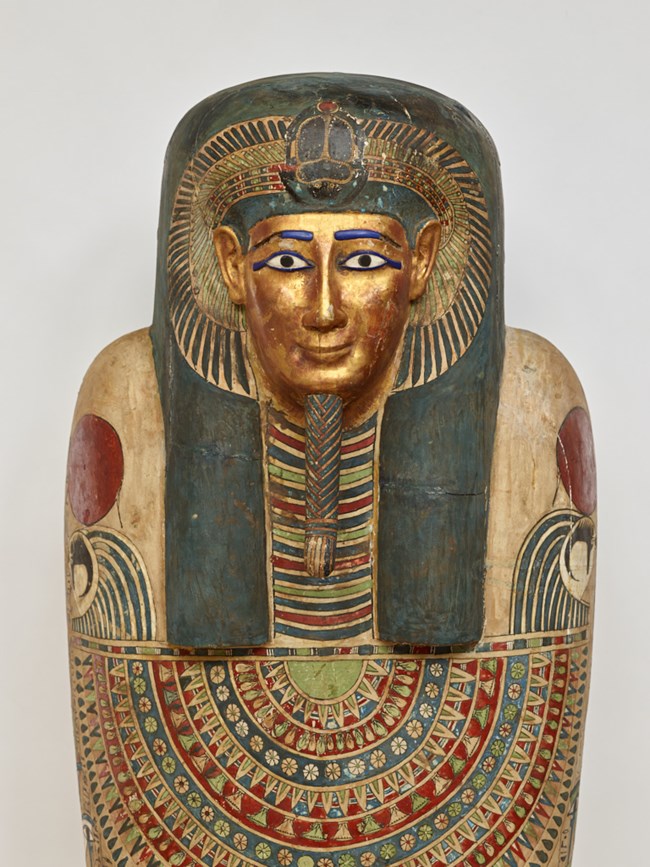
Photograph courtesy of the RISD Museum, Providence, RI.
Display of Human Remains
That was also followed closely by a project made by a RISD MFA student who had a program here that spoke all about the display of black bodies in particular. Here, he was really asking the question whether we would show a mummy if it were not of an Egyptian, weather we would feel equally free about displaying a white body.
In addition to that, there was a Brown BA thesis that discussed various displays of mummies in the United States. I think these three programs together made us rethink our approach to this display. Some of the questions they raised were: “Is a human body of work of art?”
Then another one was, “Does the human body belong in an art museum? And if so, should it even be on view?”
Then they brought up the fact that we would probably not display other human remains in an art museum, particularly Native American human remains because of NAGPRA considerations in this country. They pointedly asked, "Well, what makes it okay to show an Egyptian body?"
I think we had to come face to face with the questions, or actually the realities, that we have always seen Egyptian mummies on view in museums so much so that they have become normalized and we began to question that idea.
Is it in fact okay to continue to do so just because it's become normal? I think we started thinking that, well, no.
Just because Nesmin no longer had descendants who could speak on his behalf, didn't mean that we had permission to continue to show his body in this very public context.
Also, it became clear to us that we could still continue to talk about Egyptian religious traditions and even Egyptian religious beliefs about death and about the afterlife, but didn't have to show the mummy anymore. In fact, the coffin itself could stand in as the object from which we could educate our viewers about all these issues.
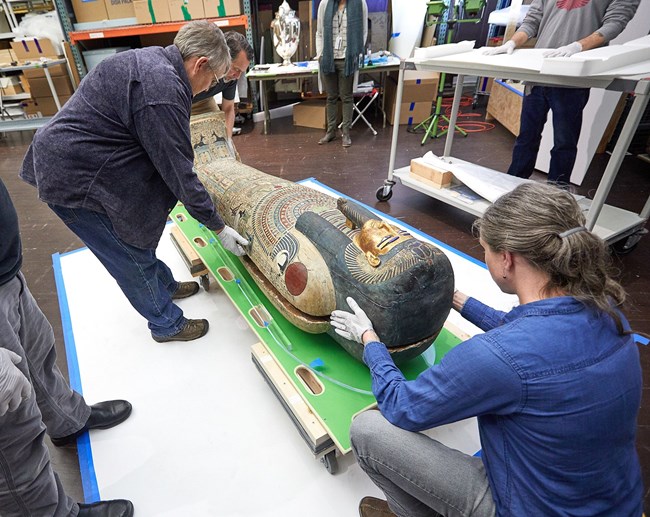
Photograph courtesy of the RISD Museum, Providence, RI.
Engaging Experts and Staff
Catherine Cooper: It sounds like there were a number of different aspects that you had to mediate in redesigning the exhibit. How did you handle those different voices?
Gina Borromeo: Well, first of all, this was a very difficult decision and one that I did not want to make alone. So, I engaged other members of the museum staff in this discussion, certainly the director, the deputy director, our conservators, our registrars or installation staff and even other curators, as well as outside experts, outside Egyptologists and anthropologists, were part of this discussion process.
In the end, the major points of consideration were continued care for the mummy and the coffin. We wanted to make sure that whatever we decided to do would not damage the mummy any further or the coffin. We have to remember here that these have always been on view separately. Essentially, that wooden coffin has not held the weight of Nesmin's mummy since the 1930s and we were really afraid that the wood had become brittle. There were cracks throughout the coffin.
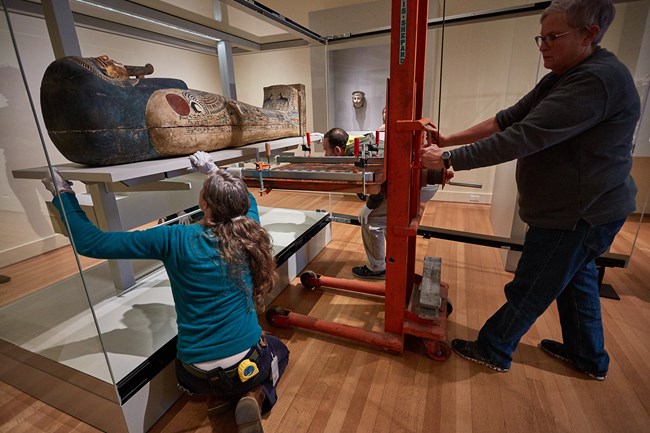
Photograph courtesy of the RISD Museum, Providence, RI.
Challenges of Coffin and Mummy Conservation
We were really scared. I don't think that's an overstatement of the situation. We were scared to put the weight in and we were afraid we would further damage the coffin.
It was interesting because our conservator, brilliant conservator, Ingrid Newman, decided that perhaps we should place little tissue bandages across the cracks of the wooden coffin so that when we put the weight of the mummy back in, we could see whether those cracks would tear the tissue paper and if so, that meant that we were causing damage to the wood and that the wood may not be able to take the mummy's weight anymore.
Fortunately, that did not happen, but I have to tell you that when we were putting the mummy into the coffin, a lot of us were holding our breaths and there was a visible sigh of relief when we discovered that in fact, the coffin was stable enough and could still hold the weight of the mummy and that essentially, it was still good for its original purpose.
Considerations About Youth Visitors
I would say that a second consideration in our decision was also consideration for museum visitors because while I would say a great majority of our visitors are school children come to the museum to see the mummy, it is a highlight actually if they're sixth grade experience here in Rhode Island, they come to the museum to study ancient culture; so ancient Egypt, Greece and Rome.
They have come to expect to see Nesmin in the museum. We had to let people know that we would no longer be showing him, but I have to tell you about something else that I think not a lot of people know and that there have been instances where our visiting public, and I'm speaking specifically about these sixth graders, there've been instances where their encounter with Nesmin is their first experience, their first vision really, of death. For some children, this has been a traumatic experience.
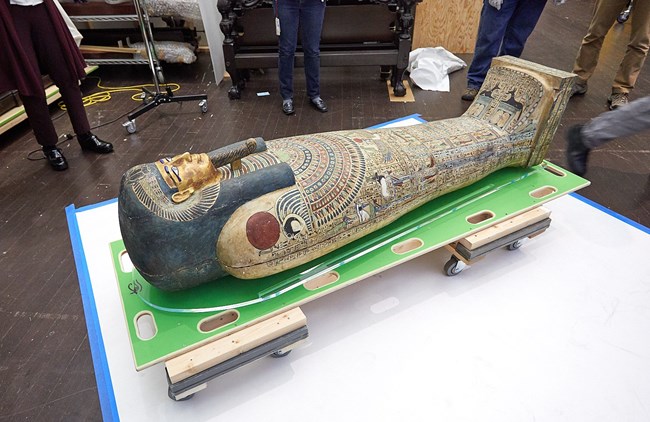
Photograph courtesy of the RISD Museum, Providence, RI.
I have heard of teachers who have had to take children out of the room because they were so shocked and disturbed by seeing a dead body in the museum. These are things that I think the general public doesn't know about, but I felt very strongly about the fact that we had to think about our museum visitors.
The RISD Museum, I don't know if you'd know it, but it is a small museum, so we don't have a space that we could segregate with a notice outside that says, "You are about to enter a room with human remains." I think visitors can just be roaming around the museum and immediately, before they know it, be face to face with the mummy and the coffin of Nesmin. So this is a way of also, not shocking people into that experience if they were not prepared for it.
Exhibit Display Considerations
Also, we worried about the coherence of the display. Because we would be taking the mummy off view, we had to deal with a whole other side of the case, and we're talking about a custom made climate controlled case here that was quite expensive and that we could not make modifications to really.
We couldn't move the support, we couldn't move the stainless steel framing supports that held the shelf for the mummy and the coffin. So we had to think about what we should put on the other side and we were able to find painted mummy portraits from the Roman period to put on the other side. But I would say that if I had my choice, I would really prefer to lower the coffin a little bit right now because you really can't see the top of the decoration on the coffin, but we had to deal with the limitations that we had and not being able to make modifications to the case.
Sharing Changes with Visitors
Catherine Cooper: In rehousing Nesmin and changing the display, it was also an opportunity for further education of why this display had changed and why RISD has Nesmin, and you were able to work that into the display, correct?
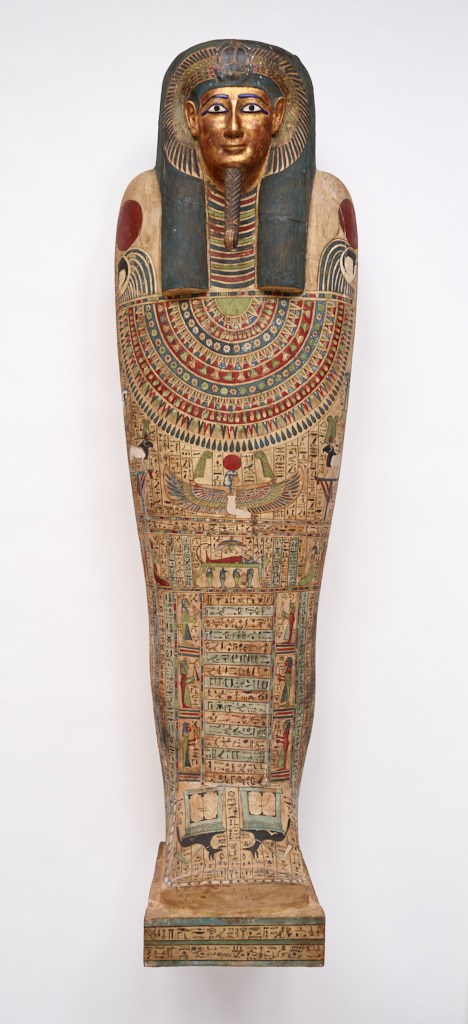
Photograph courtesy of the RISD Museum, Providence, RI.
Gina Borromeo: Once we made the decision to put Nesmin back in his coffin, we focused on how to make our decision process transparent to our visitors because I think it's a really good illustration of how museums decide to do things. We decided to make videos that when you visit the museum you can access, and we decided to make these videos so that they addressed specific questions that we thought people would want to know about.
The first question and the first video deals with, “What do you see on the coffin?” Essentially, what can we learn from the text and images that are on Nesmin's coffin? Then the second video addresses how Nesmin got from Egypt to Providence in 1938, so his history of ownership and where we think he might have been excavated and how he passed from one private collector to another before he eventually made his way to RISD.
Then the third, and I think perhaps the question that is most interesting to a lot of people is, is a body of work of art? This basically answers the question of why we chose to put Nesmin back in his coffin. We had invited an anthropologist and an Egyptologist to talk about how ancient Egyptians viewed bodies and mummies and how that has changed from antiquity through today.
Basically, touches also upon the history of the display of mummies in museums. That was very interesting. I would say for the most part, I'm really happy with the way that display turned out and really quite happy with the videos.
But should things change in the future, I know that what we did could easily be reversible and we can improve on these videos, so I leave that open. I hope that we could make this display even better for our visitors.
Catherine Cooper: Have you gotten any feedback that you'd like to share on how people have received the change to the exhibit?
Gina Borromeo: When people realized they could no longer see him, at first there was, I wouldn't say an outcry, but people were asking questions, "But why? But why?"
And gradually, now, over time, people have said, "Well, Oh goodness. Those are actually valid questions. I'm glad that the video is here to help me understand why you did what you did."
So I guess that's positive feedback.
Practicing and Moving Nesmin
In this display, we really felt a responsibility to the mummy of Nesmin and the coffin, so we took such care with it. We were concerned about making sure that we did not cause harm to the mummy of Nesmin and the coffin that we in fact, practiced the move several times before we actually did it.
Our manager of installation, Steven Wing, made a model of the mummy that was about his size and weight and we wrapped it in linen as we would eventually wrap Nesmin.
Then with members of the installation crew and with the conservators, we practiced lifting him out, lifting him from his shelf. We did this so we could identify where possible issues might arise and so that we could find solutions together about we have to support him more specifically here, and we have to lift this part up just a little more when we put him into the coffin.
At the time we actually made the move, it was done in one smooth movement. These decisions, obviously it was not taken lightly, but we tried to prepare as much as possible for the move of Nesmin back into his coffin. I like to think that he is finally now in his intended resting place and that he is finally getting the rest that he's so, so deserved and that we had temporarily interrupted. Now, he is back in the coffin and resting quietly we hope.
Catherine Cooper: Thank you so much for sharing that process with us.
Gina Borromeo: Thank you, Catherine, for allowing me to do so.
Read other Preservation Technology Podcast articles or learn more about the National Center for Preservation Technology and Training.
